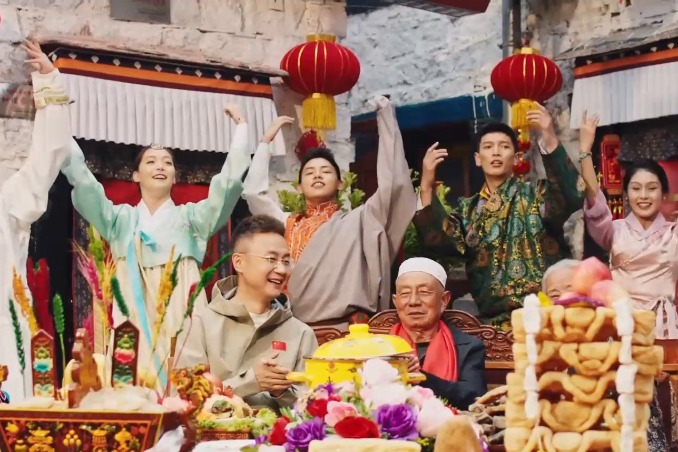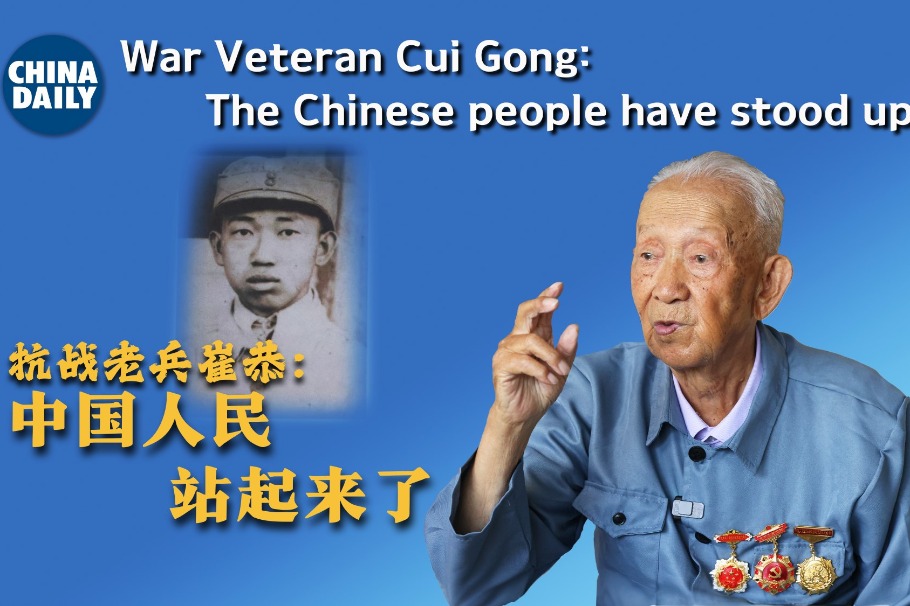Brewing up a flavorsome tale
Gongcheng oil tea depends on tradition and technique to produce a tasty and aromatic treat, Yang Feiyue reports.

Rhythmic thumping cuts through the early morning stillness in the lanes and alleys of Gongcheng Yao autonomous county in Guilin in the Guangxi Zhuang autonomous region. The sound is being made by local residents pounding fresh tea leaves with wooden hammers, before garlic, ginger and peanuts are added, and mashed together with water and oil in a heated iron pan.
Delicious aromas waft through the air.
Every so often, some of the mixture is removed and filtered through a bamboo sieve, producing a soupy beverage with a greenish yellow tint.
This liquid is the base for Gongcheng oil tea, which is usually served with a range of condiments, including steamed or roasted rice, nuts, parsley and chives. Their soft and crunchy textures create an intriguing palate experience.
The Yao people believe the beverage ensures mental vitality and sharpness, and soothes internal organs.
"Making Gongcheng oil tea is a meticulous process, both in terms of the selection of ingredients and their preparation," says Zhou Liwei.He is an inheritor of the Gongcheng oil tea-making practice that was listed as a national intangible cultural heritage in 2021, which was included in the UNESCO Representative List of the Intangible Cultural Heritage of Humanity in 2022, as part of traditional tea processing techniques and associated social practices in China.
"Its distinctive feature lies in the process of hammering, which results in a flavor that is quite different from tea made by steeping, brewing, boiling or simmering,"says Zhou, who is in his 40s, and has practiced the art with his elders since he was a child.
Decades of promotion recently led to him being added to the list of national outstanding individuals in intangible cultural heritage protection by the Ministry of Culture and Tourism.
Gongcheng is hemmed in by mountains on three sides, with higher terrain to the north than to the south. Its subtropical monsoon climate zone has made it a tea production center since ancient times.The county was established during the Sui Dynasty (581-618) when it was originally called Chacheng (City of Tea). Local history chronicles that the city was known for its significant tea cultivation and trade more than 1,000 years ago.
Gongcheng techniques have been preserved since the rise of tea culture during the Tang Dynasty (618-907).As the Yao people moved to the area from other parts of the country, they added ginger to the mix, and created a prototype of oil tea designed to ward against the humid climate.
"The people who lived in the region primarily consumed grains and meat, which were not easy to digest. Oil tea played a balancing role in their diet, as it helped regulate the digestive system," Zhou says.
Oil tea continued to be refined during the Song Dynasty (960-1279),with the addition of more ingredients. By the time of the Ming (1368-1644) and Qing (1644-1911) dynasties, the tea was fried with other ingredients before being boiled, to shorten preparation.
"We primarily use large-leaf green tea, typically harvested during the Qingming and Guyu periods," Zhou says. Among the 24 solar terms, Qingming is one that is observed in early April when the temperature begins to rise and rainfall increases.It is also the time for spring cultivation and sowing. Guyu, or Grain Rain, is observed in late April, and is the last solar term of the spring.
"When picking the leaves, the tips of the branches are also collected.The leaves undergo several processes to become tea, including pan-frying to deactivate enzymes, rolling, drying and storing," he adds.
The key to making Gongcheng oil tea lies in two crucial steps: light hammering and hard pressing.
"The tea must be gently hammered and firmly pressed, while the heat is carefully controlled to prevent the bottom of the tea pot from burning. The mashing continues until a yellow-green crust forms at the bottom of the pot," Zhou explains.
At this point, hot water is added to extract the tea flavor. "Experienced tea makers will advise you not to add cold water, as this will ruin both the flavor and the appearance of the tea," he adds.
The finished oil tea is best when it has a rich yellow-green color, and has an aroma that is a blend of tea mixed with the scent of scallions and cilantro.
"The tea has a smooth, slightly spicy taste with a hint of bitterness, followed by a lingering sweetness that leaves a memorable aftertaste,"Zhou says.
Over the years, oil tea has become an important part of social interactions for the Yao people, and an expression of hospitality to welcome esteemed guests.
As an increasing number of people from Gongcheng began to work in downtown Guilin, they brought oil tea with them, says Yu Jiajun, head of the Guilin oil tea and food association.
Some oil tea shops have since appeared, Yu adds.
Local authorities launched technical standards for the tea and service norms in 2017 to promote its development. In 2023, more than 1,800 stores across the city sold oil tea, generating around 4 billion yuan($560 million) in revenue, according to the authorities.
Yu says that dozens of new shops have opened in urban areas, some of them over 1,000 square meters in size.
Wei Yi has opened one in Nanning, the capital of Guangxi, that appeals to young consumers.
She has decorated the shop with ethnic elements of the Guangxi region, and offers crossword puzzles to add to the experience.
"I opened the shop because my family members love drinking oil tea," she says.
Wei visited Gongcheng county to study the traditional making process, and then produced a range of flavors to cater to the market, a strategy that has proved a success.
She says she has noticed that her customers are interested in traditional flavors of the tea.
Zhou has made a point of integrating the tea tradition with modern life, striving to inject vitality into the form of cultural heritage.
In addition to making oil tea, he has worked with a team to produce bottled low-calorie oil tea, canned oil tea paste, and an oil tea-based hotpot soup, to appeal to customers far and wide.
Zhou has also taken on apprentices from abroad, which he says will help spread oil tea culture further afield.
"I'm setting up classes for the younger generation interested in oil tea preparation and its culture,"Zhou says.
As a result of efforts by local government and tea makers, such as Zhou, Gongcheng oil tea was recommended as a diplomatic gift by six national government organs, including the Ministry of Commerce, in 2022.
Zhou is currently studying the history of oil tea customs and changes to tea practices to provide more theoretical support to pass the heritage on.
"Getting the award for being an outstanding individual nationwide is not only recognition of my personal efforts, but of the Gongcheng oil tea's value as precious cultural heritage," Zhou says.
He adds that this has given him more incentives to train people in the way of oil tea, engage in cultural exchange and cooperation, and apply science, such as smart production and digitalized exhibition, to broaden possibilities for the tea.

Today's Top News
- Israel's Gaza takeover plan widely condemned
- S. Korea visa waiver spurs surge in travel interest
- Top cities signal easing to support property market
- Ties bolster heritage protection
- Gaza 'takeover' will ignite another horrific chapter for the Middle East: China Daily editorial
- STAR shines for innovative companies































